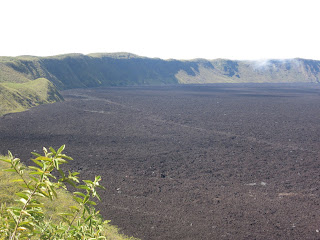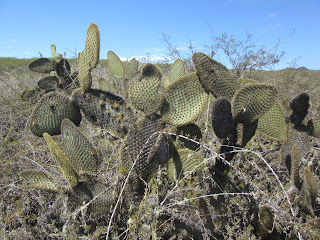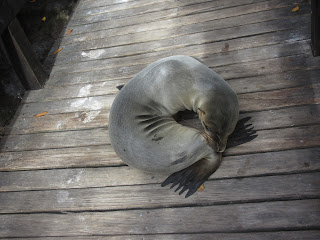I never thought I'd be so far behind writing the blog. For the last couple of weeks, we've traveled to some very out of the way places in the wilds of southern Bolivia, northern Chile and then Easter Island. The common thread in each was little or no internet, thus the delay in writing posts.
We left Isla Isabela's only town of Puerto Villamil for our morning tour to the Sierra Negra Volcano at 7:30. We'd rather rashly signed up for the tour the previous afternoon after returning from the incredible Los Tunneles snorkeling and hiking tour through the lava flows. It was a 35-minute ride on the open bus to the entrance to the park and then an 8km hike there AND back. What had we been thinking signing up for this long hike on top of the 12-mile hike we did two days ago when we visited the tortoise breeding center and then the Wall of Tears?!
Most of the houses on the island were very basic but they were all served by a comprehensive recycling system.We left Isla Isabela's only town of Puerto Villamil for our morning tour to the Sierra Negra Volcano at 7:30. We'd rather rashly signed up for the tour the previous afternoon after returning from the incredible Los Tunneles snorkeling and hiking tour through the lava flows. It was a 35-minute ride on the open bus to the entrance to the park and then an 8km hike there AND back. What had we been thinking signing up for this long hike on top of the 12-mile hike we did two days ago when we visited the tortoise breeding center and then the Wall of Tears?!
As the bus climbed made its way north into the hills, the topography changed markedly.
The temperature dropped quickly once we reached the island's higher altitudes.
The fern, planted by the entrance, grows two to three meters
a …? It was a very primitive plant and thought to have existed 260 million
years ago! The guide said park officials were attempting to bring the park back to an earlier
time, i.e. the start of life.
When we started, there were no clouds and the altitude was
just 800 meters. That compared to over 14,000 feet in Bolivia on November 8th which was where we were when I wrote up my notes from that long ago day!
Javier, our guide, commented that the Lance-Leafed Darwin’s Shrub was only endemic to Isabela
and Fernandina islands in the Galapagos.
Javier explained that we were looking at a
caldera and not a crater. The caldera, a Portuguese word, measured 7.5 kms wide
by 9 kms long. The caldera was the biggest in the world after Yellowstone.
I am the first to admit this was not my most fetching of outfits but the idea was to be warm and sun-free, not to win any beauty contests, luckily!
Javier said we wouldn’t be bothered by many mosquitoes or other biting bugs on our hike. There were rats on the island but all the feral goats that had been brought by piratess had since been eradicated because they destroyed the island’s natural ecosystem.
The lava flow path was still visible. Javier explained the smoother part (in the second photo) was
more recent compared to the other rust and white colors which were from an
earlier lava flow.
Javier told us this was a Thin-leafed Darwin´s Shrub and only found in the Galapagos.
The tree was introduced from the mainland in 1900 by a
brutal man who said he’d kill anyone who touched it. Sure enough, he stuck by
his threat when he killed a boy who touched it.
Javier stated the islands were receiving a three percent
increase yearly in the number of tourists and the goal of the national park
staff was to preserve the park for future generations. Eighty percent of
the plants on the island were endemic with the remaining twenty percent
introduced from outside. Javier and other staff feared that within just twenty
years, that ratio would be 50/50 because of the flow of people back and forth
among the islands. The Galapagos was still the best-preserved area in the world, however, according to Javier.
We were very relieved to hear this was the highest point in
the trail because it had been hard slogging up to then. The pace had also been far faster than either of us would have chosen, too. It was only later we discovered that some of the 30 or so tour participants had reservations on the afternoon boat returning to Santa Cruz and that was why Javier kept pushing everyone on and limited the number of breaks.
This sapindus plant could be used for soap.
The flycatcher bird, true to its name, waits in the tree until an insect comes by and then pounces on it, Javier mentioned!
When people first came to the
island, in order to survive they had to eat this cactus after removing the spikes. They had first noticed iguanas eating the cactus and therefore determined there was water in the plant.
Locals used to use the gas vents from inside from volcano as an oven. Sadly, some people took them to their homes as decorations. We put our hands in to see how warm it was and it was warmish but it would have taken a lonnng time to cook anything in it!
Javier explained that the giant tortoises used to try to
cross from those volcanoes in the distance all the way to where we stood but of course, it was
impassable because of the ocean in between. As a result, so many skeletons were found along the way.
Javier explained that a German scientist found the same rocks and fossils in both
Africa and in South America, thus proving the Continental Drift theory. He was considered to be a man before his time as no one had believed him. It wasn’t known until the 1930s that there was so much iron
inside the earth.
Thank goodness we could roll up our pants and our short sleeves as it got awfully hot hiking on the barren landscape in the late morning.
A lava tunnel:
Javier told us the age of the volcano was estimated to be
between 200,000 and 700,000 years old!
Javier advised the group not to go too close to the edge because a piece had fallen in recently. No, this was NOT a photo of one of us being rather careless!
One of the fumaroles:
It was so windy here at the top that we needed to hold on to
our hats or they would have blown away in an instant. We’d reached the summit about 11 and were so relieved we could sit down at last!
We could just see the ocean in the distance. Javier said
that was Elizabeth Bay and the water was the coldest there in the Galapagos at only 14-16
degrees because of a three kilometer-wide current.
When the El Niño phenomenon occurred in 1982, the current stopped and many animals died. There were an estimated 40,000 sea lions before and only 8,000 afterwards. It was amazing to find out that the giant tortoises can live without water and food for up to a year and the land iguanas can adapt by reducing the size of their skeletons in adverse weather conditions.
Prior to tours beginning on Isla Isabela in 2005-6, the only jobs were for fishermen. Since Isabela represents sixty percent of all the flora in the entire Galapagos, the park authorities want the island to remain the same and not become like another Isla Santa Cruz where Puerto Ayora is. In an earlier post, you may recall my mentioning being shocked at how ugly so much of the town was.
A small volcano:
Javier stated there will never be an airport on Isla Isabela as authorities want it to
remain small in terms of the numbers of tourists. The number of vehicles in
Puerto Villamil, the only village on the island, was supposed to be capped at
just thirty. But Steven and I sure thought we’d seen more than that number.
Admittedly, there were certainly a lot of people riding bikes everywhere but
that didn’t seem to appear to be almost the sole means of transportation.
In another attempt to stem the tide of development on the
island, Javier stated that no building was supposed to be higher than three
floors. However, we certainly saw a number of hotels with four or five floors.
When I asked Javier about these discrepancies, he admitted that people could
buy their way around the rules with the government authorities.
Javier told us that this was a mockingbird and not a Darwin
finch because it has a different beak.
We got back to the vehicle at 1ish, after hiking a pretty
grueling 16 kilometers at a far faster pace than either Steven or I were
comfortable with. If we’d known it would be such a fast pace, I think we’d have taken the later tour that didn’t have a
specific ending time. Also, Esteban, our guide from yesterday’s fabulous Los Tunneles
tour, was the guide for the afternoon Sierra Negra tour. On the flip
side, it was cooler weather when we set out so that was a bonus.
As we were hiking back, Javier told me the UICM has declared 18 hot spots in the world because of
their phenomenal biodiversity. The top nation was Colombia followed by
Indonesia, China and Ecuador. The Galapagos are, of course, part of Ecuador. He then mentioned that Rachel Carlson, in her book 'The Silent Spring,' was one of
the first people to warn people the world was walking toward the sixth
extinction and proceeding at a pace far greater than the previous one.
Javier talked about the interdependence of life and animals on the planet and
what a dangerous pace mankind is living.
This looked it belonged in a ‘boat cemetery’ and not just
off the main drag!
Lina: This should be your mantra!We were pretty wiped when we got back to the hotel but Steven convinced me we should go back to Concha Perla after resting for a bit.
We had to again hop over the sea lions who were lazing on the
boardwalk!
The sea lions created a bit of a traffic jam, Galapagos style!
We snorkeled without wet suits for about 45 glorious
minutes in the bay. We have no photos to prove it but we saw a sea horse, sea urchins,
starfish, schools of about 50 parrot fish and more coral and different colors of
it than we did yesterday on the Los Tunneles tour. Luckily, there were pockets of warm water so, while the water
was refreshing, it was certainly acceptable to swim in for under an hour. There were no changing facilities on the small dock so we
did the best we could without baring all!
Steven joking about how wiped he was after the long hike, the walk through town to La Concha Perla AND the snorkeling!
We’d gone again without lunch so decided to walk into town
to get dinner. A taxi, aka truck, stopped and offered a ride for $1.50. That
sounded too good a deal to pass up since we were chilly from swimming and
hadn’t thought to bring any warm clothing with us.
Chris and John: Another Halloween pumpkin for you both!
We stopped in a shop for a minute and saw these massive 950
gram cans of tuna and tins of fruit wrapped in bags for some reason.
Sadly, the town's park in the center of town was very run down.
The monument paid homage to the island's history as a former penal colony and the sad chapter with the forced building of the Wall of Tears we'd hiked to a couple of days previously.
Saturday night on the main street of Puerto Villamil!
Restaurant row or basically the only place to grab a meal in
town!
Next post: An unforgettable morning with iguanas and flamingos before a turbulent passage back to Isla Santa Cruz.
Posted on November 28th, 2017, from Santiago, Chile.

























































































No comments:
Post a Comment